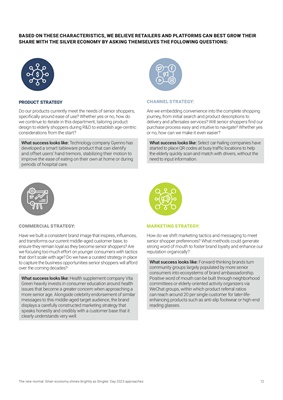
12
The new normal: Silver economy shines brightly as Singles' Day 2023 approaches
What success looks like: Technology company Gyenno has
developed a smart tableware product that can identify
and offset users' hand tremors, stabilizing their motion to
improve the ease of eating on their own at home or during
periods of hospital care.
What success looks like: Health supplement company Vita
Green heavily invests in consumer education around health
issues that become a greater concern when approaching a
more senior age. Alongside celebrity endorsement of similar
messages to this middle-aged target audience, the brand
displays a carefully constructed marketing strategy that
speaks honestly and credibly with a customer base that it
clearly understands very well.
What success looks like: Select car-hailing companies have
started to place QR codes at busy traffic locations to help
the elderly quickly scan and match with drivers, without the
need to input information.
What success looks like: Forward-thinking brands turn
community groups largely populated by more senior
consumers into ecosystems of brand ambassadorship.
Positive word of mouth can be built through neighborhood
committees or elderly-oriented activity organizers via
WeChat groups, within which product referral ratios
can reach around 20 per single customer for later-lifeenhancing
products such as anti-slip footwear or high-end
reading glasses.
BASED ON THESE CHARACTERISTICS, WE BELIEVE RETAILERS AND PLATFORMS CAN BEST GROW THEIR
SHARE WITH THE SILVER ECONOMY BY ASKING THEMSELVES THE FOLLOWING QUESTIONS:
PRODUCT STRATEGY
COMMERCIAL STRATEGY:
CHANNEL STRATEGY:
MARKETING STRATEGY:
Do our products currently meet the needs of senior shoppers,
specifically around ease of use? Whether yes or no, how do
we continue to iterate in this department, tailoring product
design to elderly shoppers during R&D to establish age-centric
considerations from the start?
Have we built a consistent brand image that inspires, influences,
and transforms our current middle-aged customer base, to
ensure they remain loyal as they become senior shoppers? Are
we focusing too much effort on younger consumers with tactics
that don't scale with age? Do we have a curated strategy in place
to capture the business opportunities senior shoppers will afford
over the coming decades?
Are we embedding convenience into the complete shopping
journey, from initial search and product descriptions to
delivery and aftersales services? Will senior shoppers find our
purchase process easy and intuitive to navigate? Whether yes
or no, how can we make it even easier?
How do we shift marketing tactics and messaging to meet
senior shopper preferences? What methods could generate
strong word of mouth to foster brand loyalty and enhance our
reputation organically?